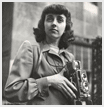 |
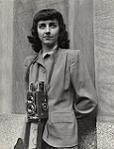 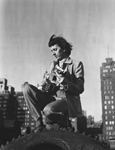
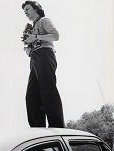 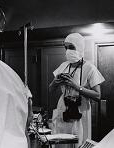 |
Introduction As a child growing up in the 1930s, Esther Bubley earned extra money by photographing the neighborhood children and selling the pictures to their parents. As a high school student, she was impressed by the FSA photographs of the Great Depression and decided to become a photographer. Her big break came in 1942 when, at the age of 21, Roy Stryker hired her to work in the darkroom at the Office of War Information (OWI), where he and his FSA photographers had recently been transferred. When Stryker was recruited by Standard Oil Company (New Jersey) to compile a photographic library, he brought Bubley and several other OWI photographers with him. In 1950 and 1951, Bubley also worked for Stryker on the Pittsburgh Photographic Library. At the same time, she continued to freelance for Standard Oil and developed a thriving career separate from Stryker. After World War II, most middle-class American women returned to the home. But Bubley made it to the top of the highly competitive and overwhelming male field of photojournalism. She had a steady stream of assignments from Life and the Ladies' Home Journal in the 1940s and 50s when illustrated magazines where at the peak of their popularity and influence. At the same time, her client list expanded to include Pepsi-Cola International, Pan American World Airways, and UNICEF, who sent her on assignments throughout the continental United States and around the world. Bubley is recognized for both her artistic composition and her superb story telling ability. Edward Steichen admired Bubley's work and used it frequently in exhibitions at MoMA during his tenure as directory of photography. In 1956, Helen Gee gave Bubley a one-woman show at her legendary Greenwich Village coffee shop and gallery, the Limelight, at a time when photography was still struggling to be recognized as art. Ordinary people were Bubley's favorite subjects. She enjoyed photographing children, especially naughty ones. Her direct approach and unassuming manner allowed her to get amazingly intimate photographs. Bubley also loved animals, and her archive includes many photographs of Sheba (her Dalmatian) and Sheba's friends. |
 |
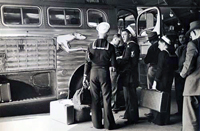 |
Office of War Information (OWI) The Office of War Information (OWI) was a U.S. propaganda agency during WWII. The photographic section was headed by the legendary Roy Stryker, who had been transferred over from the Farm Security Administration (FSA), along with most of the FSA photographers. The FSA's iconic images of the Great Depression were famous world-wide, and they had inspired a high school girl named Esther Bubley. In 1942, at age twenty-one, Bubley was a novice photographer. Stryker hired her to work in the OWI's darkroom, and she suddenly found herself working alongside the giants in the field of documentary photography. |
 |
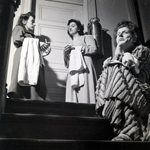 |
Dissin's Guest House Dissin's guest house was a boarding house that operated from 1938 to 1963, providing accommodations for young Jewish government workers in Washington, DC. During 1942 and 1943, Bubley visited the guest house frequently because her oldest sister, Enid, lived there. When Bubley wanted to build up her portfolio of documentary photography, she chose to photograph life at Dissin's. Stryker was sufficiently impressed to include the photos in the official OWI collection, and to start giving Bubley more important assignments. |
 |
 |
Bus Story 1943 In 1943, Bubley spent four weeks documenting bus travel, which had increased greatly with the wartime rationing of gasoline and tires. She rode Greyhound busses to Pittsburgh, Indianapolis, Chicago, Columbus, Cincinnati, Louisville, Memphis, Nashville, Chattanooga and back to Washington. During her trip, she photographed passengers, employees, and a garage in Pittsburgh. |
 |
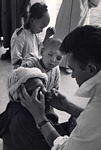 |
UNICEF Trachoma Project Trachoma, one of earliest known eye diseases, is an infection that often leads to blindness. In 1953, UNICEF and the French government launched a project to control Trachoma in Morocco, and they assigned Esther Bubley to cover it. She traveled to the treatment areas around Ouarzazate in the lowlands south of the Atlas Mountains, bouncing along in the ill-tempered UNICEF car, to record people receiving medical attention. The program resulted in a "summer without eye sickness." |
 |
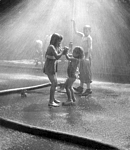 |
The Children's Bureau The Children's Bureau, founded in 1912, is the oldest United States federal agency for the welfare of children. At first, the Bureau was primarily concerned with the problem of exploitive child labor. By the 1940s, child labor had been outlawed and the Bureau's focus shifted to health and welfare issues. In the 1948, Esther Bubley documented some of the Bureau's programs, and they published her work in their magazine The Child. |
 |
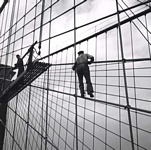 |
Standard Oil Company (New Jersey) Roy Stryker left the OWI in 1943 to spearhead a massive photo-documentary project for Standard Oil Company (New Jersey) (SONJ). Admidst allegations of colluding with the German chemical company I.G. Farben and hindering the war effort, SONJ needed to repair their reputation. They decided to do so by documenting the role of their company and oil in the lives of Americans. Stryker recruited Bubley and several other OWI photographers to SONJ. Bubley's assignments included Texas oil towns, a cross-country bus trip, New York Harbor, and international locations. Her Bus Story series won a coveted first award from the School of Journalism of the University of Missouri in conjunction with the Encyclopedia Britannica. |
 |
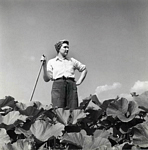 |
Gilbert & Barker Gilbert & Barker Manufacturing Company was a foundry making tools and equipment for the oil industry. When Bubley photographed the facility in 1944, it was located in West Springfield, Massachusetts and owned by Standard Oil Company (New Jersey). |
 |
 |
Denmark Because the kingdom of Denmark consists of 500 islands plus Jutland, the only part attached to the continent of Europe, ferries play an important role in its transportation system. When these images were made in 1954, 23 ferries were operated by the Danish State Railway and a number of private ferry companies. Some connected the islands within Denmark, and others made trips to Sweden, Germany, and England. |
 |
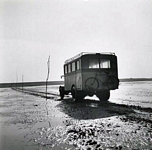 |
Island of Mano, Denmark In 1954, a tank truck from the storage plant at Esbjerg made monthly deliveries of Esso fuel oil, gasoline and kerosene to the island of Mano, four miles off the coast of Jutland. During ebb tide the sea was low enough so that the loaded truck could cross in about half an hour following a track marked by dead trees pushed into the sandy bottom. After each trip the truck was washed thoroughly to prevent salt water corrosion. Fuel oil was pumped into underground tanks at the dairy, gas and kerosene were delivered in metal containers. |
 |
 |
Pepsi-Cola International Pepsi-Cola International sent Bubley to Central and South America in the mid-1950s to photograph areas where they manufactured and sold their product. They published her images in their corporate magazine Panorama, which was distributed to their bottlers and shareholders. |
 |
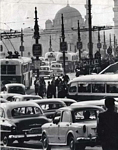 |
Pan American World Airways Pan American World Airways flew Bubley around the globe in the mid-1960s to photograph exotic travel destinations serviced by the airline. PanAm also sent Bubley to Cape Kennedy (now the Kennedy Space Center at Cape Canaveral) to document their ground operations and unmanned space shots. They published her images in their corporate magazine The Clipper, which was distributed to employees and shareholders. |
 |
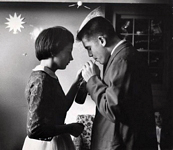 |
Woman's Day: Eight-thirty to Midnight/p> The photo-essays Bubley produced for Woman's Day were primarily for articles about raising children. The article "Eight-thirty to Midnight, or Don't be afraid to give a party!" offered advice on planning a party for a teenager. The photographs are from a surprise birthday party given for a teenage girl in Westport, CT. The party took place in December 1957, but the article was published a year later in December 1958. |
 |
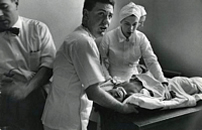 |
Emergency Tracheotomy Bubley spent three weeks living at Pittsburgh Children's Hospital on assignment for the Pittsburgh Photographic Library. She was on the scene when a little girl was rushed in, unable to breath. With no time to waste, the doctors performed an emergency tracheotomy on a desk in the lobby, and Bubley photographed the action. Edward Steichen used 15 of the images in the exhibition Diogenes with a Camera at the Museum of Modern Art in New York. Steichen even mounted her contact sheets on the wall to show that every frame counted. |
 |
 |
Polio Poster Made for the campaign to fight polio that was sponsored by the National Foundation for Infantile Paralysis, this poster was displayed in the Museum of Modern Art in 1950.Formerly known as infantile paralysis because it mainly affects children, poliomyelitis (polio) is an infectious disease that causes permanent paralysis and even death in a small percentage of its victims. Because polio is easily transmitted from person to person, it was a major public health threat in the United States until a vaccine was introduced in 1955. Franklin D. Roosevelt (U.S. President 1933-1945) had permanent paralysis of his legs as the result of a polio infection that he contracted in 1921. |
 |
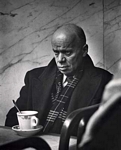 |
Automat In the 1930s, 1940s, and 1950s New York City had more than three dozen Horn & Hardardt automats, Art-Deco restaurants with a great wall of gleaming vending machines where each food item was displayed in its own small, well-lit, windowed-compartment. Patrons selected their food, put a coin in the slot, twisted the knob, opened the door to the compartment, and removed their food. |
 |
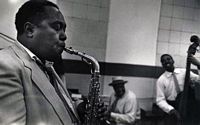 |
Charlie Parker/Norman Granz Jam Session Coincidentally, Esther Bubley was in Los Angeles on assignment for the Ladies' Home Journal at the same time that her friend David Stone Martin was there to make sketches at a Charlie Parker/Norman Granz jam session. Martin invited Bubley to come along. She did, and she made the only images of what later became a famous jam session. Martin based his sketch for the album cover on a collage of Bubley's photographs. |
 |
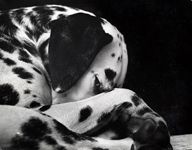 |
Sheba Sheba, adopted around 1962, was the first of Esther Bubley's three beloved Dalmatians. She was succeeded by Fancy, and then by Cinders. Being as passionate about animals as about photography, Bubley took more pictures of her dogs and their pals than most parents take of their children. Sheba's special friend Van, a great dane, appears with Sheba in many of Bubley's photographs from the mid-1960s. |
 |
 |
Medical & Mental Health Esther Bubley developed a specialty in stories about health care. She recorded such dramatic events as open heart surgery, an emergency tracheotomy, state-of-the-art cancer treatments, and severely disturbed mental patients. Some of these stories were commissioned by the hospitals or drug companies, some were commissioned by magazines, and occasionally Bubley pursued a story with a more personal connection, as when she photographed surgery being performed on the infant daughter of her closest friend. |
 |
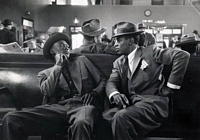 |
New York City Esther Bubley was rarely without a camera. Wherever she was, she recorded what was happening around her, whether on assignment or not. During the 54 years she lived in New York City, she captured thousands of city scenes, both typical and bizarre. In the process, she documented numerous fixtures of city life that have now disappeared including the Automat and the gum machines on subway platforms. From the mid-1960s on, one of her favorite locations was Central Park, where she spent several hours a day walking her dog, and, of course, taking pictures. |
